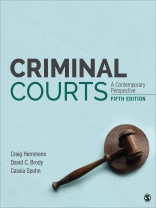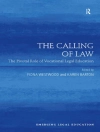Comprehensive and engaging, Criminal Courts: A Contemporary Perspective explores all aspects of courts and related areas which are crucial to the criminal justice system. Written by three nationally recognized experts in the field, this text examines court structure, courtroom actors, trial and appeal process, and in addition, judicial decision making, specialized courts, and comparative court systems.
By presenting up-to-date key cases, data, and current controversial discussions such as the death penalty or legalization of cannabis, this fifth edition provides students with opportunities to view topics from the perspectives of the participants involved in the process and take a position on the issue that is raised.
Зміст
Preface
Acknowledgments
About the Authors
Section I: The Purpose and Structure of American Courts
Chapter 1: Introduction: Law and the Judicial Function
Why Study Courts?
What Is Law?
The Code of Hammurabi
Two Opposing Perspectives: Consensus and Conflict
What Is the Relationship of Law to Justice?
The Rule of Law
Justice, The Law, and Packer’s Models of Criminal Justice
Two Models of Criminal Justice
Judicial Functions
How Judges “Make Law”
Development of the Common Law System
The Role of Courts in the Criminal Justice System
Chapter 2: Sources of Law
Introduction
Sources of Law
Sources of Individual Rights
Standard of Review
Incorporation of the Bill of Rights Into the Fourteenth Amendment
Chapter 3: Types of Law
Introduction
Types of Law: Criminal and Civil
Chapter 4: Court Organization and Structure
Introduction
Jurisdiction
The Structure and Jurisdiction of U.S. Courts
A Brief Historical Overview
Federal Courts
State Courts
Court Actors
Overview of the Criminal Process
Section II: Courtroom Actors and the Courtroom Work Group
Chapter 5: Prosecutors
Introduction
Historical Evolution of the American Prosecutor
The Federal Prosecutor
State Prosecutors
The Prosecutor’s Duties
To Prosecute or Not, That Is the Question
Assistant Prosecutors at Work
The Expansion of the Prosecutor’s Discretionary Power
Prosecutorial Ethics and Misconduct
Community Prosecution
Chapter 6: Defense Attorneys
Introduction
Defense Attorney’s Role in the Criminal Justice System
Historical Development of the Right to Counsel
Indigent Defense Systems
Caseload Limits and Compliance
Private Versus Appointed Counsel: Which Is Better?
Effective Assistance of Counsel
A Plea Bargain and Inadequate Counsel
Measuring Competency for Self-Representation
Ethics and Lawyer–Client Relationships
Realities of Being a Defense Attorney
Chapter 7: Judges
Introduction
Roles and Duties of Judges
Judicial Selection
Judicial Socialization and Development
Judicial Accountability and Judicial Independence
Judicial Performance Evaluations
Accountability for Judicial Misconduct
Chapter 8: Criminal Defendants and Crime Victims
Introduction
Criminal Defendants
Victims and the Criminal Courts
Chapter 9: The Jury
Introduction
History of Jury Trials
The Role of the Jury
Limits on the Right to Trial by Jury
Jury Size and Unanimity Requirements
The Selection of Jurors
Reforms to the Jury System
Jury Nullification
Section III: Court Processes
Chapter 10: Pretrial Procedures
Introduction
Arrest
Booking
The Charging Decision
Information
Indictment
Initial Appearance
Arraignment
Discovery
Pretrial Motions
Plea Bargaining
Chapter 11: The Criminal Trial
Introduction
Opening Statements
The Presentation of Evidence
Calling Witnesses
Evidence and Rules of Evidence
Closing Arguments
Instructing the Jury
Jury Deliberations and Verdict
Wrongful Conviction and Exoneration of the Innocent
Randall Kennedy’s Critique
Chapter 12: Sentencing
Introduction
The Goals of Sentencing
The Judge’s Options at Sentencing
How Do Judges Decide? Modeling the Sentencing Process
Chapter 13: The Appellate Process
Introduction
Appealing to a Higher Court
The Appellate Courts
The “Right” to Appeal
The Writ of Habeas Corpus
How Do Appellate Courts Decide?
Oral Arguments Before the Supreme Court
Chapter 14: Specialized Courts
Introduction
California Voters Approve Proposition 47
Problem-Solving Courts
Drug Treatment Courts
Domestic Violence Courts
Other Problem-Solving Courts
Juvenile Courts
Glossary
References and Suggested Reading
Case Index
General Index
Про автора
Cassia Spohn is School Director and Foundation Professor of Criminal Justice at Arizona State University. She is the author of several books, including The Color of Justice: Race, Ethnicity, and Crime in America (with Sam Walker and Miriam De Lone) and How Do Judges Decide? The Search for Fairness and Equity in Sentencing. She has published a number of articles examining prosecutors’ charging decisions in sexual assault cases and exploring the effect of race/ethnicity on charging and sentencing decisions. Her current research interests include the effect of race and gender on court processing decisions, victim characteristics and case outcomes in sexual assault cases, judicial decision making, sentencing of drug offenders, and the deterrent effect of imprisonment. In 1999, she was awarded the University of Nebraska Outstanding Research and Creative Activity Award.












